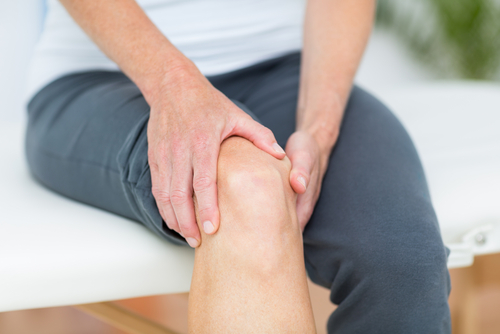Where would we be without our knees? Many of us take these complex joints for granted… until we start experiencing knee pain, then we discover just how important knee health is to quality of life.
Our knees have a lot of moving parts that allow them, and us, to move the way we do. Because our upper and lower leg bones meet and hinge the way they do, we can walk, run, squat, jump, and easily turn. But it’s not just bones that allow for this motion; cartilage, muscles, tendons and ligaments all help our knees do their job.
But, with so many moving parts, it becomes all too easy for one or more of them to become painfully damaged or diseased. In fact, the American Academy of Orthopaedic Surgeons reports that injuries to knee joints are responsible for sending over 10 million Americans to the doctor each year. And, according to the CDC, roughly 1 in 2 people may develop symptomatic knee osteoarthritis by the time they reach 85.
When our knee health takes a hit, our quality of life takes a hit as well. Knee pain can mean the difference between a fulfilling life and years of painful, limited mobility.
Sadly, many people assume knee pain is an unavoidable symptom of aging. A recent survey by the American Osteopathic Association (AOA) found that close to one in two Americans believe that pain is part of life. 41% of respondents believe pain is “a standard part of the aging process.”
While many assume knee pain only affects the elderly, the study found that close to 65% of Americans between the ages of 18 to 34 also experience chronic knee pain.
All combined, that’s an awful lot of Americans living with knee pain. And how many pop a pill when the pain becomes too intense? In the moment it seems like a quick fix, but over the counter medications, if taken too often for too long, come with negative side effects like ulcers to liver damage to heart attacks and stroke. In fact, the FDA just strengthened the cardiovascular warnings on the bottles of ibuprofen and naproxen.
The good news is there are things you can do to prevent knee pain. Here are 7 simple ways:
Take Omega-3
Omega-3 fatty acids are considered essential fatty acids, meaning they are necessary for optimal health. However, the body can’t make them, so we must get them through the food we eat and supplements we take.
Omega-3 fatty acids are found in high concentrations in cold water fish such as tuna, salmon and mackerel. They may also be obtained through quality supplements. Clinical studies have found that diets rich in omega-3 fatty acids may help people suffering from osteoarthritis in the knees, as well as other joints. Omega-3s have been found to reduce joint pain and stiffness and improve the pace at which patients can walk and climb stairs.
[Editor’s note: don’t worry about trying to find the best Omega-3 supplement for your joint pain… I’ve done the work for you. Click Here for the purest, most potent form of Omega-3, and it tastes good too!]
Weight Training
If our knee joints do not have strong muscles supporting and stabilizing them, they are much more prone to injury and pain. We start to lose muscles mass in our 30s and this loss accelerates as we age, so it’s particularly important for people in their 40s, 50s and 60s to keep all of the muscles in their lower body strong. Core strength (those abdomen and back muscles) also plays a part in knee stability. And remember: weight training isn’t about seeing who can lift the most weight, it’s about making your muscles work harder than they usually do, even if that means starting with very low weights.
Walk More
You know the phrase, “Move it or lose it.” Well this is good advice when it comes to the cartilage in our knees. Walking is vital in keeping cartilage healthy. Those who are at risk for osteoarthritis in particular should walk at least 1,000 steps a day in order to keep their cartilage moving and their joints healthy and limber.
Shed Some Pounds
The more weight on your body, the more pressure on your knees to support it. In fact, the Arthritis Foundation cites obesity as the number one risk factor for osteoarthritis. Each pound you are able to lose translates into 4x less pressure on your knees. Less pressure means less wear and tear on your cartilage. So, if you were to lose just five pounds you would be sparing your knees 20 added pounds of pressure!
Don’t Forget to Warm Up
As we’ve mentioned, exercise is great for your knees, not only as a way to lose weight but also to keep your cartilage moving. Having said that, it’s incredibly important to warm-up before you get into your main exercise program. While it’s tempting to just get right to it and start your squats or leg lifts, doing so can cause tight muscles to become strained, which inevitably leads to joint pain. Gently warming up the muscles before exercise becomes even more important as we age. Just five to ten minutes of cardio is all it takes to get the blood flowing into the muscles to lessen risk of knee injury.
Go Low Impact
Staying on the topic of exercise for a little longer, it’s important that whatever exercise you do is gentle on your knees. Low-impact exercises like walking, swimming, and yoga are great for your knees, whereas high-impact activities such as running are bad for the knees, no matter what age you are. To be safe, choose activities where at least one foot is always remaining on the ground. Again, think walking, yoga, golf, and even biking and swimming.
Consider a Knee Brace
There are different kinds of knee braces on the market and many of them relieve knee pain in different ways. Some braces will help to alleviate swelling while others improve the tracking of the kneecap. Still others will improve knee mechanics and provide stability.
While it’s always best to seek the advice of an orthopedic doctor to fit you with just the right brace, there is no harm in buying an over-the-counter sleeve with a cutout in the interim to help reduce pain and fatigue and give your knee added support.
If you’ve been living with knee pain, or any other joint pain for that matter… you don’t have to suffer any longer. Joint pain is NOT a “normal part of growing older”. It actually comes from an imbalance in gut bacteria, which is caused by a lifetime of poor diet, antibiotics, environmental chemicals, and other factors.
But just like most problems in life, it HAS a solution. Click Here for The Joint Pain Solution – written by a doctor who has spent the majority of his life treating chronic pain.
If you’re serious about putting an end to your joint pain – you need to go straight to the ROOT CAUSE of your pain. Click Here for a more integrative and natural approach to pain relief, that is not only safe, but effective and readily available.
 Validating...
Validating... 







Leave a Reply